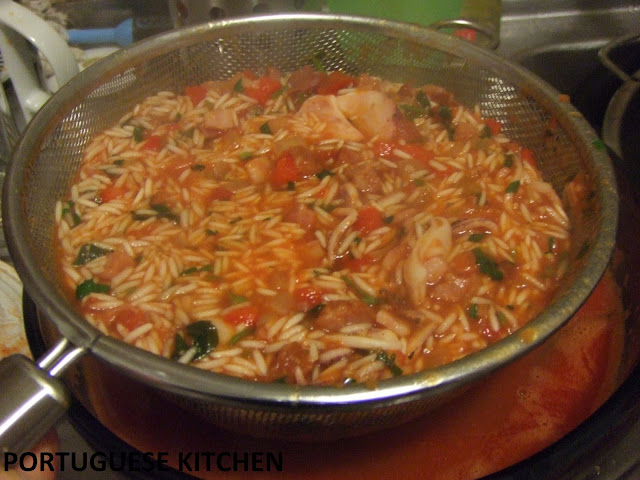I know I know, seafood again. I think I should have named this blog Portuguese seafood kitchen.
I guess you all know by now that my heritage is from the Algarve, so I do love my seafood. It may seem as though my family and I eat nothing but seafood but I promise we don't. Usually just once per week. Seafood I find is really easy and quick to cook. I know some people out there are afraid of seafood, thinking it's really hard to cook and very time consuming.
A lot of the dishes I feature are traditional fare and so the majority of recipes were made up by peasants who had little money, time and culinary skills to design anything very complicated. This is not to say the food isn't tasty, on the contrary it's delicious. Simple I feel doesn't mean it lacks flavour or depth.
These recipes are very simple and easy to prepare, with a hectic life I have little time to spend slaving over a hot stove especially in this 30+ degree weather.
RECIPE
- 1 medium brown onion, chopped small dice
- 6 garlic cloves, minced
- 1 red capsicum, diced small
- 6 slices, prosciutto, chopped
- 1 chorizo, skin removed,chopped small pieces
- 2 rashes bacon, rind removed, chopped
- 3 bay leaves
- 150ml olive oil
- 1 cup long grain rice
- 1 tea paprika
- 1 bunch parsley, chopped, keeping stalk part aside
- 300ml white wine
- 800g tinned tomato pulp
- 1 lt water
- 3 tea salt
- 2 kg calamari fresh, medium size
- Holding the calamari firmly, grasp the head and pull gently, twisting if necessary, to pull the head away from the body without breaking the ink sac. The internal body and tentacles will come with it.
- Cut the tentacles from the head just below the eyes.
- Set aside the the tentacles and the wings to use (they're edible and tasty).Keep the ink sack, if desired.
- At the top of the body, there is a clear piece of cartilage. Pull it out and discard.
- If the squid has an outer spotted membrane-type skin, pull it off.
- Under cold water, wash the tube carefully, inside and out, to get rid of any sand or other remaining tissues, and wash the tentacles carefully as well, making sure you don't break the tube.
- Keep the tentacles and wings on the side, cutting them into small bite size pieces.
On a medium heat place a fry pan and heat the olive oil. Add the onion and garlic saute for 1 min then add the capsicum, and bay leaves, saute a further 3 min until the ingredients are soft. Then add chorizo, prosciutto and bacon and fry for 4 min. Add the tentacles and the wings of the calamari.
Add the rice stir for 3 min adding paprika and the stalks of parsley. Coat the rice well with all the ingredients, then add the white wine, tomato pulp, chopped parsley, water and salt. Bring to the boil then turn off the heat immediately (the rice will at this stage still be raw, this is what you want).
With a large sieve drain the rice mixture, into a bowl keeping the liquid. Transfer the rice to separate bowl.
Once the rice mixture is a bit cool, fill each calamari tube with some rice with a teaspoon. Secure the end of the calamari tube with a toothpick so that none of the mixture falls out. Place each filled calamari tube onto a plate.
In a baking dish place some rice if any is left. Then place calamari tubes on top of the rice. Then place the reserved liquid on top and cover the calamari tubes. Place a drizzle of virgin olive oil on top of the calamari. Cover with foil and bake for 30 minutes on 180 degrees.
NOTE
- I always separate stalk and leaf. I then fry the stalk part, as this add extra flavour to the food.
- Try to get medium size fresh calamari. I find that the frozen calamari is usually too large and only good to be used for deep fried calamari.
- Bring the rice to a boil then switch off heat immediately otherwise the rice will over cook. The rice finishes cooking in the calamari.





















